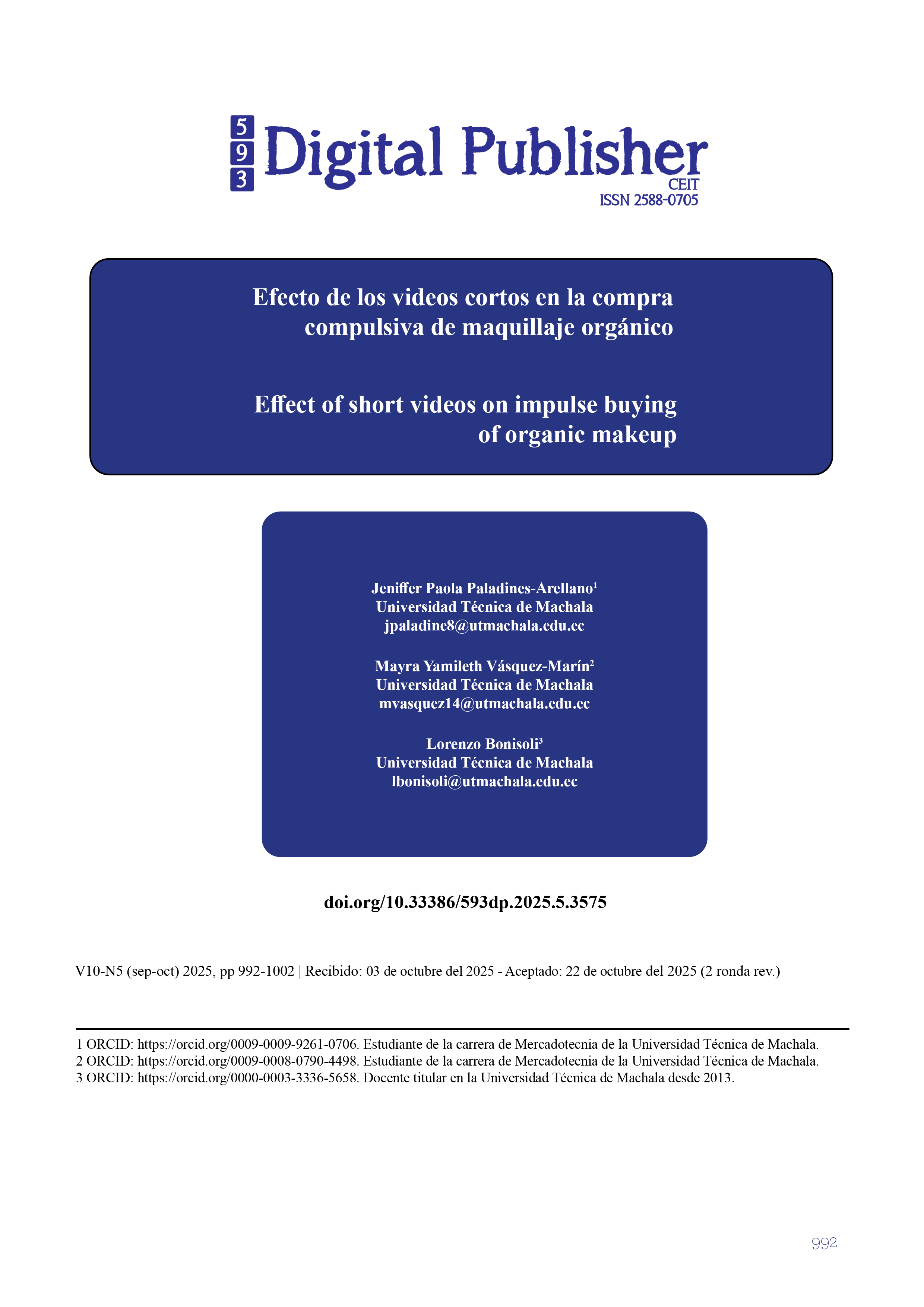Efecto de los videos cortos en la compra compulsiva de maquillaje orgánico
Contenido principal del artículo
Resumen
La compra compulsiva en entornos digitales es un comportamiento cada vez más presente, impulsado especialmente por el consumo de videos cortos en redes sociales. Estos contenidos, al combinar entretenimiento y recomendación, pueden estimular decisiones de compra poco planificadas, incluso en categorías relacionadas con el consumo sostenible.
El objetivo de esta investigación fue analizar cómo la gratificación inmediata y la sorpresa influyen en la compra compulsiva de maquillaje orgánico promovido en plataformas digitales. Se aplicó un enfoque exploratorio y cuantitativo a 343 jóvenes de la Generación Z, utilizando la técnica PLS-SEM para evaluar los resultados.
Los hallazgos revelan que las emociones desencadenadas por los videos cortos impulsan la adquisición de productos ecológicos no solo por su valor ambiental, sino también por el placer y la novedad que transmiten. La sorpresa se identificó como el factor más determinante en la decisión de compra, mientras que la gratificación inmediata refuerza el deseo de consumir de forma rápida y emocional.
Estos resultados ofrecen implicaciones valiosas para las marcas de cosmética sostenible y los profesionales del marketing digital, al destacar la importancia de diseñar estrategias audiovisuales que canalicen los impulsos de compra hacia un consumo más consciente y responsable.
Descargas
Detalles del artículo

Esta obra está bajo una licencia internacional Creative Commons Atribución-NoComercial-CompartirIgual 4.0.
1. Derechos de autor
Las obras que se publican en 593 Digital Publisher CEIT están sujetas a los siguientes términos:
1.1. 593 Digital Publisher CEIT, conserva los derechos patrimoniales (copyright) de las obras publicadas, favorece y permite la reutilización de las mismas bajo la licencia Licencia Creative Commons 4.0 de Reconocimiento-NoComercial-CompartirIgual 4.0, por lo cual se pueden copiar, usar, difundir, transmitir y exponer públicamente, siempre que:
1.1.a. Se cite la autoría y fuente original de su publicación (revista, editorial, URL).
1.1.b. No se usen para fines comerciales u onerosos.
1.1.c. Se mencione la existencia y especificaciones de esta licencia de uso.
Citas
Ardyan, E., & Sanapang, G. M. (2023). Online Compulsive Buying and Brand Addiction in Indonesia: The Importance of Using Fear of Missing Out and Social Commerce Interactivity. The Winners, 24(2), 117–126. https://doi.org/10.21512/tw.v24i2.10817
Arnold, M. J., & Reynolds, K. E. (2003). Hedonic shopping motivations. Journal of Retailing, 79(2), 77–95. https://doi.org/10.1016/S0022-4359(03)00007-1
Bagozzi, R. P., & Yi, Y. (1988). On the evaluation of structural equation models. Journal of the Academy of Marketing Science, 16(1), 74–94. https://doi.org/10.1007/BF02723327
Ciocodeică, D. F., Chivu, R. G., Popa, I. C., Mihălcescu, H., & Barghier, I. (2025). Hedonic and Impulsive Consumer Behavior Stimulated by Social Media: Implications for Sustainable Fashion Marketing. Sustainability (Switzerland), 17(11). https://doi.org/10.3390/su17115198
Crespín, H. J., Fernández, A. N., & Bonisoli, L. (2025). Influenciadores y su efecto en la compra de productos verdes: Un estudio de la generación Z ecuatoriana. Kairós, revista de ciencias económicas, jurídicas y administrativas, 8(14), 46–66. https://doi.org/10.37135/kai.03.14.03
Cronbach, L. J. (1951). Coefficient Alpha and the Internal Structure of Tests. Psychometrika, 16(3), 297–334. https://doi.org/10.1007/BF02310555
Dang, T. Q., Nguyen, L. T., & Duc, D. T. V. (2025). Impulsive Buying and Compulsive Buying in Social Commerce: An Integrated Analysis using the Cognitive-Affective-Behavior Model and Theory of Consumption Values with PLS-SEM. SAGE Open, 15(2). https://doi.org/10.1177/21582440251334215
Dijkstra, T. K., & Henseler, J. (2015). Consistent Partial Least Squares Path Modeling. MIS Quarterly, 39(2), 297–316. https://doi.org/10.25300/MISQ/2015/39.2.02
Dong, W. W., Wang, Y. Q., & Qin, J. (2023). An empirical study on impulse consumption intention of livestreaming e-commerce: The mediating effect of flow experience and the moderating effect of time pressure. Frontiers in Psychology, 13. https://doi.org/10.3389/fpsyg.2022.1019024
Duan, X. (2025). Mental simulation and compulsive buying: a multiple mediation model through impulse buying and self-control. Frontiers in Psychology, 16. https://doi.org/10.3389/fpsyg.2025.1507031
Fornell, C., & Larcker, D. F. (1981). Evaluating Structural Equation Models with Unobservable Variables and Measurement Error. Journal of Marketing Research, 18(1), 39–50. https://doi.org/10.1177/002224378101800104
Gong, X., Yee, C. L., Lee, S. Y., Saif, A. N. M., Liu, M., & Anonthi, F. (2024). Unveiling the enigma of blind box impulse buying curiosity: The moderating role of price consciousness. Heliyon, 10(24). https://doi.org/10.1016/j.heliyon.2024.e40564
Hair, J. F. . (2014). A primer on partial least squares structural equations modeling (PLS-SEM). SAGE.
Hoang, C. C., & Khoa, B. T. (2022). Impulse Buying Behavior of Generation Z customers in Social Commerce: Flow Theory Approach. Journal of Logistics, Informatics and Service Science, 9(4), 197–208. https://doi.org/10.33168/LISS.2022.0413
Huo, C., Wang, X., Sadiq, M. W., & Pang, M. (2023). Exploring Factors Affecting Consumer’s Impulse Buying Behavior in Live-Streaming Shopping: An Interactive Research Based Upon SOR Model. SAGE Open, 13(2). https://doi.org/10.1177/21582440231172678
Jöreskog, K. G. (1971). Statistical Analysis of Sets of Congeneric Tests. Psychometrika, 36(2), 109–133. https://doi.org/10.1007/BF02291393
Kim, J., & Kim, M. (2020). Spectator e-sport and well-being through live streaming services. Technology in Society, 63. https://doi.org/10.1016/j.techsoc.2020.101401
Manizia, L., Borah, T., Bhattacharjee, R., Saikia, J., Dutta, A., & Boruah, J. (2023). Instant Gratification and The Digital Natives: A Pilot Study. Educational Administration: Theory and Practice. https://doi.org/10.53555/kuey.v29i3.7471
Mantik, J., Prasetyo, J. H., & Wiharso, G. (2025). The role of green and digital marketing in driving impulsive buying. In Mantik Journal (Vol. 9, Issue 1). Online.
Moon, M. A., Faheem, S., & Farooq, A. (2022). I, me, and my everything: Self conceptual traits and compulsive buying behavior. Journal of Retailing and Consumer Services, 68, 103075. https://doi.org/10.1016/j.jretconser.2022.103075
Nguyen, T. H. N., Tran, N. K. H., Do, K., & Tran, V. D. (2024). The Role of Product Visual Appeal and Sale Promotion Program on Consumer Impulsive Buying Behavior. Emerging Science Journal, 8(1), 297–309. https://doi.org/10.28991/ESJ-2024-08-01-021
Qu, Y., Khan, J., Su, Y., Tong, J., & Zhao, S. (2023). Impulse buying tendency in live-stream commerce: The role of viewing frequency and anticipated emotions influencing scarcity-induced purchase decision. Journal of Retailing and Consumer Services, 75, 103534. https://doi.org/10.1016/j.jretconser.2023.103534
Rook, D. W., & Fisher, R. J. (1995). Normative Influences on Impulsive Buying Behavior. Journal of Consumer Research, 22(3), 305. https://doi.org/10.1086/209452
Sağtaş, S. (2023). Effects of Flow Experience on Impulse Buying Intent: An Application in E-Retailing. The Journal of International Scientific Researches, 8(3), 478–489. https://doi.org/10.23834/isrjournal.1349827
Streukens, S., & Leroi-Werelds, S. (2016). Bootstrapping and PLS-SEM: A step-by-step guide to get more out of your bootstrap results. European Management Journal, 34(6), 618–632. https://doi.org/10.1016/j.emj.2016.06.003
Tenenhaus, M., Vinzi, V. E., Chatelin, Y.-M., & Lauro, C. (2005). PLS path modeling. Computational Statistics & Data Analysis, 48(1), 159–205. https://doi.org/10.1016/j.csda.2004.03.005
Wang Yilu. (2025). View of Exploring the mechanism of blind box experience marketing driving consumer behavior from the perspective of biological behavioral patterns_ An analysis of the mediating effect of customer surprise. https://doi.org/10.62617/mcb1393
Wu, I. L., Chiu, M. L., & Chen, K. W. (2020). Defining the determinants of online impulse buying through a shopping process of integrating perceived risk, expectation-confirmation model, and flow theory issues. International Journal of Information Management, 52. https://doi.org/10.1016/j.ijinfomgt.2020.102099
Yin, B., & Shen, Y. (2024). Development and Validation of the Compensatory Belief Scale for the Internet Instant Gratification Behavior. Heliyon, 10(1). https://doi.org/10.1016/j.heliyon.2024.e23972




